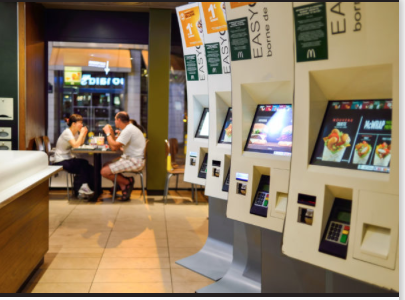
Wendys Follows McDonald’s By Installing Self-Serve Kiosks In Response to Minimum Wage Hike Ridiculousness
So, now that some areas have successfully forced businesses to raise their minimum wage to $15 per hour, fast food restaurants are working on ways to keep their prices down for their customers, and be able to pay their skyrocketing employment costs.
“What the supporters of a higher minimum wage just don’t get, is that it hurts poor unskilled workers the most.”
The first new great thing in fast food industry’s fight to stay alive is the self-serve kiosk, which allows their customers to walk up to a self-serve kiosk and place their own food order. This one change alone will do away with 2-5 $15 per hour part time employees in each restaurant, and replace the worker with a full-time robot that will never work high or drunk, call in sick or ask for a raise.
The next machines to replace human workers in the fast food restaurant kitchen will be robots that actually make the food.
In the very near future there will be no use for overpaid high school dropout idiots in fast food, making the same as some people who went to college. Instead there will be a team of robots flipping burgers, making fries, and filling drinks for FAR less that $15 per hour.
Personally, I cannot wait for the day when every aspect of the fast food kitchen is automated, which will speed up service, increase quality, and hopefully decrease the cost, since they will no longer need to employ anymore expensive high school drop-outs.
In response to recent minimum wage hikes, Wendy’s is now replacing fast food workers with robots.
The fast food chain announced it will start automating all of its restaurants by installing self-serve kiosks in 6,000 locations by the end of the year.
Although McDonalds has already been experimenting with kiosks, Wendy’s announcement is the largest roll-out to date and will likely spark a trend leading to fully robotic restaurants.
“Wendy’s President Todd Penegor said it will be up to franchisees to decide whether or not to adopt the kiosks in their stores, noting that many franchise locations have had to raise prices to offset wage increases,” Slashdot reported. “California’s decision to gradually raise the minimum wage to $15 by 2022 will impact Wendy’s 258 restaurants, all of which are franchise-operated.”
“About 75% of 200-plus Wendy’s restaurants are run by franchisees in New York, a state that is also on its way to $15.”
It’s simple economics: when labor costs are too high to stay in business, owners will look for alternatives – including burger flipping robots.
One such robot, developed by the San Francisco start-up Momentum Machines, can replicate a fast food worker by shaping burger patties from ground meat, grilling them, adding the specified amount of ingredients, and serving them to customers on a conveyor belt.
Many fast food chains may be forced to outsource jobs to these machines because they cannot afford to stay in business paying workers $15 an hour, given the number of restaurants that have already closed after Seattle enacted such a minimum wage.
“The businesses that couldn’t afford it either shut down or laid off workers, and the businesses that could afford it simply shifted some money around by eliminating benefits and putting those dollars toward wages,” Joshua Krause of the Daily Steeple reported. “What the supporters of a higher minimum wage just don’t get, is that it hurts poor unskilled workers the most.”
Stand Up To Government Corruption and Hypocrisy – usbacklash.org
